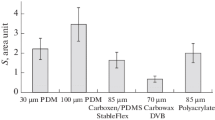Abstract.
Human urine samples after fish consumption have been investigated by low-temperature gas chromatography with inductively coupled plasma mass spectrometric detection after sample derivatization by hydride generation (HG/LT–GC/ICP–MS). This analytical technique enabled the identification of organometal(loid) compounds in human urine; species of the six elements germanium, arsenic, selenium, tin, antimony, and mercury were determined.
Three different organic selenium species, two germanium species, seven arsenic species, four tin species, five antimony species, and one species of mercury were found; 18 of the 22 species detected could be identified. The relative detection limits ranged between 2 and 12 pg x L–1 (x=element). These organometal(loid) compounds probably build up in the human body under the influence of micro-organisms, in the presence of hydrogen sulfide and methane, in the human intestine.
Similar content being viewed by others
Author information
Authors and Affiliations
Additional information
Electronic Publication
Rights and permissions
About this article
Cite this article
Kresimon, J., Grüter, U. & Hirner, A. HG/LT–GC/ICP–MS coupling for identification of metal(loid) species in human urine after fish consumption. Fresenius J Anal Chem 371, 586–590 (2001). https://doi.org/10.1007/s002160101087
Received:
Revised:
Accepted:
Published:
Issue Date:
DOI: https://doi.org/10.1007/s002160101087




